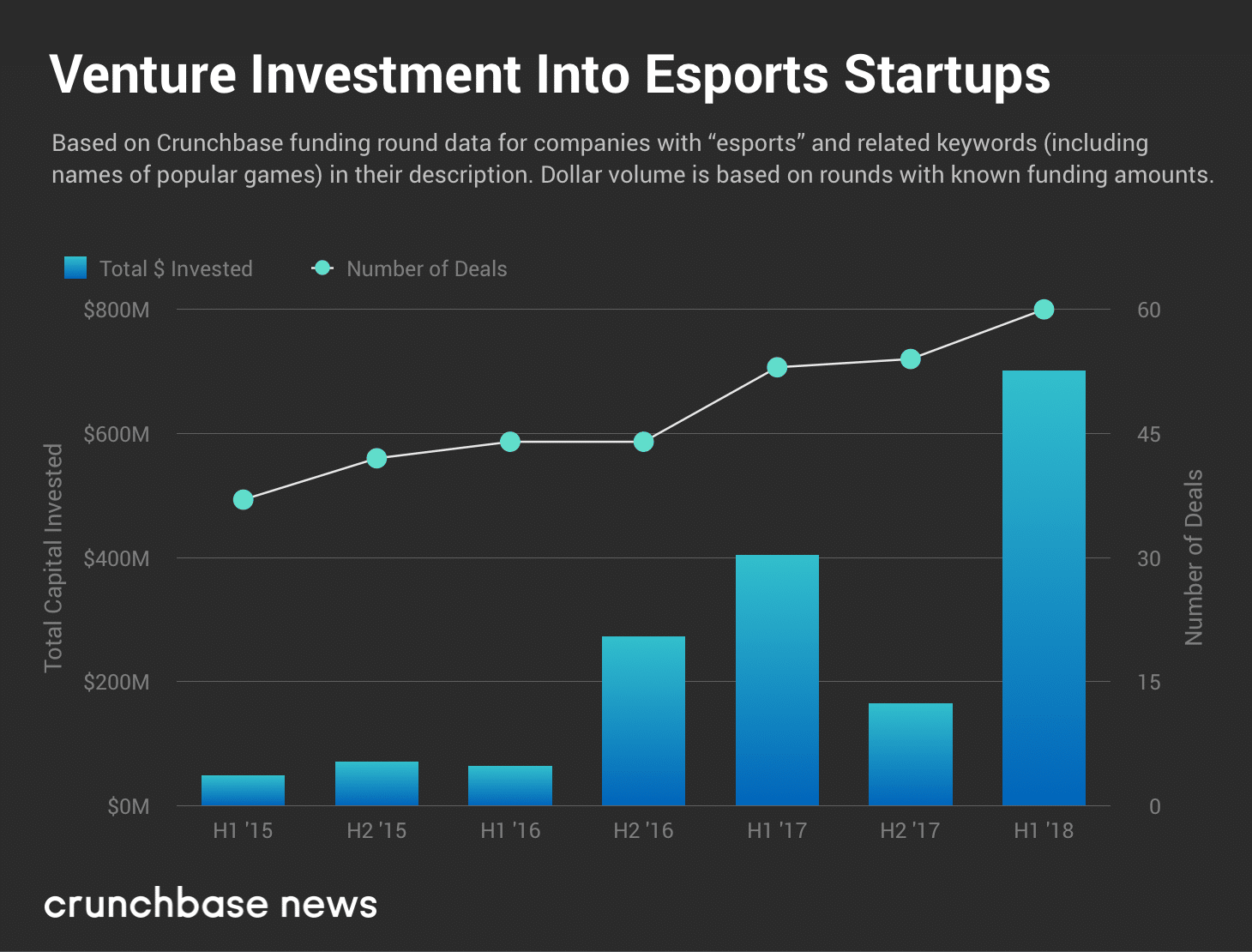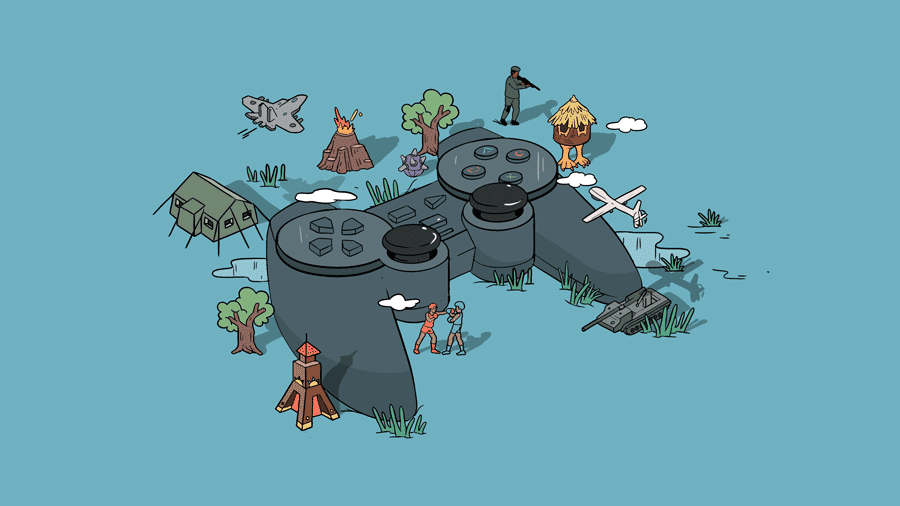The past decade has been a ride for the gaming industry.
25 years ago, people would have never believed you could play deep, engrossing games on mobile phones, let alone play against other people on their phones. Ten plus years ago, it was almost unthinkable for tens of millions of gaming fanatics (and millions of viewers at home) to watch a live event of competitors going head to head.
A summary of the gaming industry
Gaming was a basement hobby, although a global industry. It wasn’t a mainstream competitor to professional sporting events like an NFL or NBA game. The gaming industry was also certainly not an industry worth over $138 billion.
Perform your own market research and upgrade to Crunchbase Pro.
And yet, here we are in 2018, not only with the above a reality, but with all signs pointing to a future which will be even bigger. Consider the facts:
- Crunchbase News recently reported that global venture investment in video gaming surged to $701 million over 60 deals in the first half of 2018—up 73 percent compared to $403.7 million raised across 53 deals in the first half of 2017.
- If that’s not enough proof, look no further than Disney’s majority stake purchase in BAMTech for streaming rights to the hit game, League of Legends.
- Considering that Disney also recently pulled all its content from Netflix, secured a 60% controlling stake in Hulu, and plans to launch its own streaming service, it’s safe to say that gaming content in this booming niche will be a major part of their viewer and user acquisition strategy moving forward.
- Plenty of other deals with eSports, video game streaming, major mainstream brand sponsorships, and massive events have been made, as well—including major online players like Amazon (especially via Twitch), Facebook, and others.
The gaming industry has never experienced a bigger boom on so many fronts.


The gamer’s dilemma
Yet, underlying all this exciting growth is a darker truth: the talented developers responsible for creating the games we know and love have been given an impossible ultimatum:
- Join a major studio (such as Blizzard Entertainment, Bungie, Zynga) backed by a massive publisher (Sony, Nintendo, Microsoft, Activision, etc.).
- Try your hand at making it on your own.
The problem is, the latter option is almost unachievable.
See, while the gaming market has exploded over the past five years––mostly thanks to the adoption of smartphones, the Internet, and soon, blockchain tech––according to a fascinating 2017 study by Indeed, “…jobs for game developers and game designers have shown a strong decline since 2014, with a 65% drop in the percentage of [job] postings.”
This while “game developer job searches have grown over 50%.”
The opportunity gap in gaming
Development opportunities funnel into only a few specific silos where power is concentrated. This leaves a massive opportunity gap separating indie developers from those signed with big publishers. And with the amount of money those publishers are making and able to spend, that gap is only going to widen, especially when considering marketing and distribution costs. Ultimately, this leaves independent developers disenfranchised and even unable to bring their ideas to market.
I’ve witnessed this shift personally, going back to my earliest work experience with PlayStation over 15 years ago. The sad truth is, if this opportunity gap is not addressed, we risk losing the essence of what has always made gaming unique and special: the independent creativity of talented game developers.
How blockchain can help game developers
Today, there’s a significant discussion on how blockchain tech could solve some of the gaming industry’s issues.
As the CEO of the world’s first public gaming blockchain, MagnaChain, I can tell you that Blockchain technology, as amazing as its intended promise looks to be, isn’t the “magic fairy dust” many people claim it to be. In fact, this technology faces the same challenges as other emerging technology. Blockchain gaming will only prove useful if managed properly, implemented purposefully with an actual business model in mind, and adopted widely over time. That’s the only way we’ll address the root causes which fuel the overall game industry’s growing opportunity gap. It’s the only way, in a sense, to make sure the blockchain gaming community works for everybody.
At some point, Blockchain technology must stop being an R&D project and truly show some real-world use cases and adoption. This has been said over and over in recent months and finally, we are starting to see some positive signs of this taking shape—regardless of the tumultuous crypto markets.
Game developers’ most pressing pain points
Of those root game developer pain points mentioned above, there are two which prove most pressing.
-
Profit and Loss (P&L)
Today, developers pay an inordinate amount of the revenue they generate just to distribute their games, let alone market them.
This is especially a problem in the app stores. Gaming developers pay 30% of profits to Google Play and Apple’s App Store. In extreme cases, like China, developers who want nationwide distribution pay anywhere from 20 to 80% of their revenue.
Developers are left with very little revenue left over to do any additional marketing, to pay their normal overhead, or to invest in new IP.
And when you factor in the reality that most games are now free-to-play––a fact which, according to blockchain gaming company Alto.io, further increases the cost to produce content and acquire users––and that only 1.9% of active players ever contribute revenue, it’s no wonder that small developers are becoming less able to recoup the requisite development costs and stay profitable.
-
100% Asset Ownership
This, as it happens, is the issue which the blockchain has the most potential to ameliorate. If the problem is solved successfully–by way of a more empowered gamer and developmental community–it will also work to address the P&L concerns cited above.
The problem at present has to do with how money moves inside the video game industry. Previously, if a player owned a sword, gun, or car in a game, the digital asset was in their account. However, the asset sat on the servers of the specific game’s publisher or developer. Additionally, the asset is traded within the publisher’s marketplace’s rules and regulations.
Creating one-of-a-kind assets
Eventually, independent developers began building and uploading their games to a blockchain. However, those assets can now be one-of-a-kind, non-fungible tokens, which promote scarcity. For the first time in history, players can own 100% of their assets through progression, gameplay, or purchase.
Business models already detail how much people are willing to pay for these kinds of rare assets. Rare assets may range from six or seven figures. Users buy, sell, or trade assets according to a publisher’s strict rules or in secret. Since gaming publishers didn’t want others making money off their digital assets, they operated as a black market or forum.
Now, gamers can do whatever they want with the assets they own: buy, sell, trade, or distribute.
How to redistribute profits to gamer developers with blockchain gaming
And those profits can, in turn, be shared with the developers who created the assets in the first place.
In other words, decentralization could, in time, help create a token economy which more directly benefits players. It will liberate developers to compete outside of the existing mega-publisher ecosystem.
There are companies already working to this end, too. Alto.io is one––their approach to utilizing digital assets and game rewards is remarkably innovative––as are Monetizr.io and Gaex.com. These companies level the playing field and ultimately grow a community which produces better games, closing the developer opportunity gap.
More than anything, the health, and viability of that community are key. And it’s exactly what the blockchain technology and its decentralization promote best.
But, again, make no mistake: the blockchain is no magical silver bullet.
Especially, while blockchain gaming is at such a nascent stage.
Blockchain gaming’s ultimate success depends on the decentralization of the gaming community. Its future also depends on the management of the subsequent token economy.
And we have a long way to go. Esports might be the hottest topic these days, but if it remains extremely difficult for independent developers to be part of the larger ecosystem, it’s not unfathomable that a small handful of publishers and games will continue dictating which (and whose) games the world will be playing.
That’s why our team at MagnaChain are working so hard, alongside the companies I cited above as well as others, game associations and other partners. We’ve been heavily focused on creating not just a public blockchain and related ecosystems and toolsets for game developers, but also on educating the industry at large around the underlying issues impacting these disparate parties.
That’s how both players and developers will benefit most equitably from this next and potentially most influential era in gaming history.
It’s gonna be a wild ride for all…that’s for sure.
Hal has amassed over 15 years of international video games, technology, and Blockchain industry. He has experience across global markets and has lived and worked across Asia, Europe, and the US. Hal is the CEO of MagnaChain, a recently launched new public Blockchain protocol. Hals is also the Co-Founder of SmartChain Media, a new streaming entertainment platform. It merges fan-based media and premium content, social media and crowdfunding into one, easy-to-use platform. Hal also advises both Asia and US-based Blockchain related companies.





